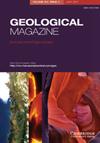Geochemical characterization, U–Pb apatite geochronology, and geodynamic significance of olivine minette dykes from the Julian Alps, NE Italy
IF 2
3区 地球科学
Q3 GEOSCIENCES, MULTIDISCIPLINARY
引用次数: 1
Abstract
Abstract We investigated olivine minette dykes from the Rio Colan Valley of the Julian Alps (NE Italy) to provide new constraints on the mantle geochemistry underneath this extreme sector of the Italian Southern Alps. Petrographic observations, high Mg#s, high Cr and Ni contents, low Dy/YbCN ratios and flat heavy rare earth element (REE) profiles imply these are primary magmas derived from a depleted peridotite with olivine and garnet as possible residual phases. However, high K2O and incompatible trace element contents, coupled with superchondritic Nb/Ta ratios, suggest that the source was modified into a rutile–phlogopite-bearing carbonated peridotite by multiple metasomatic events such as recycling of crustal material and carbonatitic metasomatism related to an old orogenic event and rutile-rich metasomatism linked to the Pangaea break-up. Laser ablation – multi-collector – inductively coupled plasma – mass spectrometer (LA-MC-ICP-MS) U–Pb geochronology of apatites from two dykes yielded differences between unforced and forced discordia ages up to ∼45 Ma, likely due to the initial 207Pb/206Pb correction adopted. Nonetheless, because forced discordia and 206Pb/238U weighted mean ages are overall similar within the uncertainty, our preferred interpretation is that olivine minettes intruded and crystallized at ∼67 Ma. The age and anorogenic signature of these magmas are consistent with the regional extensional tectonics in the Julian Alps due to the advance of the external Dinaric front following Adria plate eastward subduction. Eventually, we show also that Rio Colan magmas are geochemically hybrid products between lamprophyres and lamproites compared with similar Italian and Western Mediterranean volcanics.意大利东北部朱利安阿尔卑斯地区橄榄石矿脉地球化学特征、U-Pb磷灰石年代学及地球动力学意义
摘要:我们调查了朱利安阿尔卑斯山脉(意大利东北部)里奥·科兰山谷的橄榄石矿脉,为意大利南阿尔卑斯山脉这一极端地区下方的地幔地球化学提供了新的约束。岩石学观察、高Mg#、高Cr和Ni含量、低Dy/YbCN比率和平坦的重稀土元素(REE)剖面表明,这些是源自贫橄榄岩的原始岩浆,橄榄石和石榴石可能是残余相。然而,高K2O和不相容的微量元素含量,再加上超软骨岩Nb/Ta比率,表明该来源被多次交代事件(如地壳物质的再循环和与古老造山事件有关的碳酸岩交代作用)和与盘古大陆解体有关的富金红石交代作用)改性为含金红石-金云母的碳酸橄榄岩。激光烧蚀-多收集器-电感耦合等离子体-质谱仪(LA-MC-ICP-MS)对两个岩脉的磷灰石进行U–Pb地质年代测定,得出了高达~45Ma的非受迫和受迫不整合年龄之间的差异,这可能是由于采用了最初的207Pb/206Pb校正。尽管如此,由于强迫不整合和206Pb/238U加权平均年龄在不确定性范围内总体相似,我们的首选解释是橄榄石矿在~67Ma侵入并结晶。这些岩浆的年龄和非造山特征与朱利安阿尔卑斯山脉的区域伸展构造一致,这是由于亚得里亚板块向东俯冲后Dinaric外锋的推进。最终,我们还表明,与类似的意大利和西地中海火山岩相比,里奥·科兰岩浆是煌斑岩和煌斑岩的地球化学混合产物。
本文章由计算机程序翻译,如有差异,请以英文原文为准。
求助全文
约1分钟内获得全文
求助全文
来源期刊

Geological Magazine
地学-地球科学综合
CiteScore
4.70
自引率
0.00%
发文量
111
审稿时长
3 months
期刊介绍:
Geological Magazine, established in 1864, is one of the oldest and best-known periodicals in earth sciences. It publishes original scientific papers covering the complete spectrum of geological topics, with high quality illustrations. Its worldwide circulation and high production values, combined with Rapid Communications and Book Review sections keep the journal at the forefront of the field.
This journal is included in the Cambridge Journals open access initiative, Cambridge Open Option.
 求助内容:
求助内容: 应助结果提醒方式:
应助结果提醒方式:


